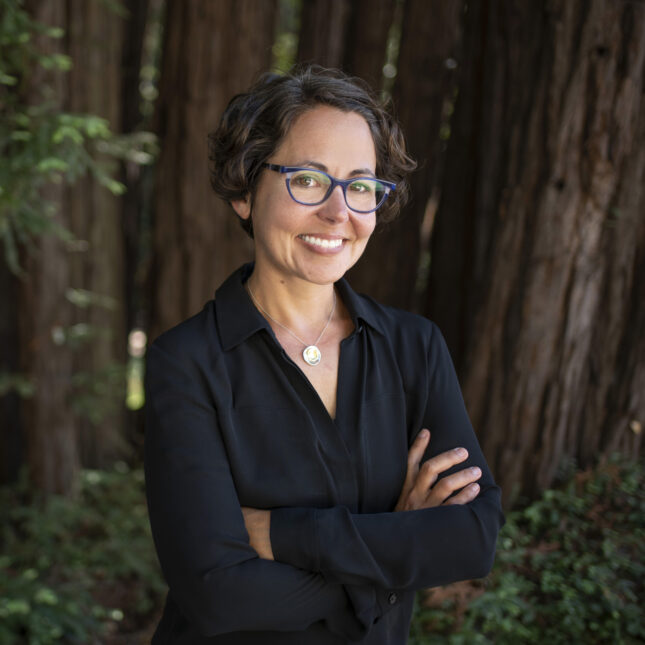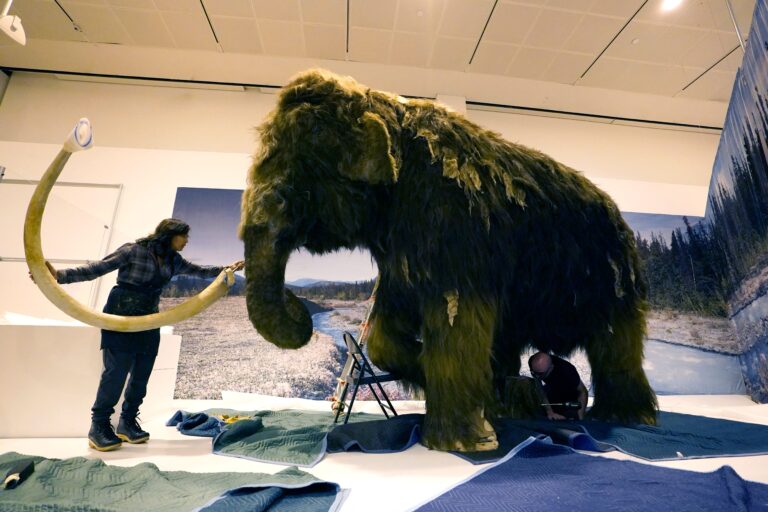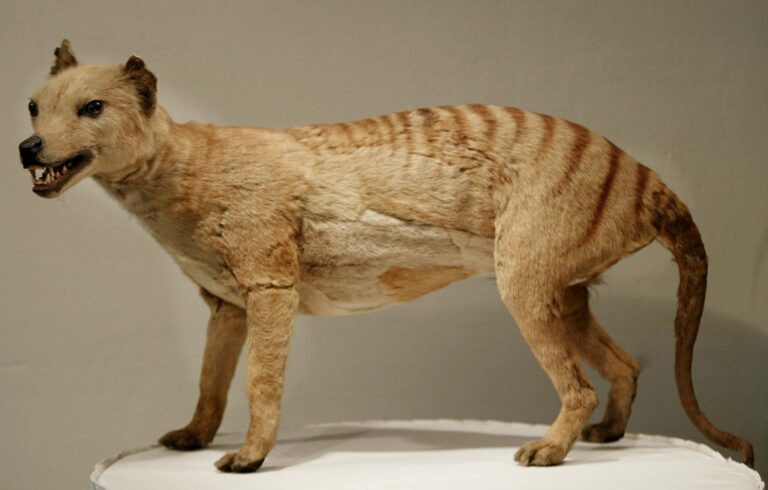
Humans have long tinkered with the evolutionary trajectories of other species. Thousands of years ago we tamed wolves into dogs and transformed a wild grass into the agricultural wonder wheat. Within the past few centuries, we exterminated the Tasmanian tiger and doomed the dodo bird to oblivion. Now, we stand on the brink of an ambitious new era in how humans may transfigure life around us: by pursuing the science of de-extinction, or the resurrection of species once lost to this world.
Beth Shapiro is an evolutionary biologist, an ancient DNA adventurer who has collected fossilized bison bones from Arctic permafrost, and a titan in the de-extinction movement. She co-led the Paleogenomics Lab at the University of California, Santa Cruz, was a Howard Hughes Medical Institute investigator and a MacArthur Fellow, and is the author of the books “How to Clone a Mammoth: The Science of De-Extinction” and “Life as We Made It: How 50,000 Years of Human Innovation Refined—and Redefined—Nature.” In 2022 she announced that her team sequenced the genome of the dodo bird.
Recently, Shapiro was named chief scientific officer of Colossal Biosciences, a biotech company with its sights set on bringing back such fallen fauna as the woolly mammoth, dodo bird and Tasmanian tiger, or thylacine. Shapiro spoke with STAT about CRISPR, conservation, and her recent move from academia to biotech. She also discussed how the scientific journey to reviving extinct species may provide insight into better protecting and preserving ecosystems in the present day. This interview has been edited for length and clarity.
How did your interest in ‘de-extinction’ start?
I have worked in ancient DNA for my whole graduate career since 1999, when I joined Alan Cooper’s group in Oxford. I was fascinated by this combination of paleontology, evolutionary biology, and molecular biology. At that time, it was just beginning. It was crazy to think that we could actually recover DNA sequences from things that had been dead for tens of thousands of years, and then use that to try to better understand how species, populations, communities, and entire ecosystems shift and change over evolutionarily significant time scales.
Whenever we would publish one of these papers, often we got a lot of media attention, and it was very exciting to think about mammoth DNA, ancient bison, or extinct horses. But really, the question that they were most interested in asking us was, “What does this mean about bringing extinct species back to life?” At first it was disappointing. I really wanted to talk about the cool stuff that we’re learning, and all they wanted to talk about is “Jurassic Park” or Pleistocene Park. But then, you start to understand it’s that type of question that engages people with the science.
Gradually over my career, I’ve just gotten more and more engaged with what [de-extinction] would actually look like. I’ve really begun to appreciate how the technologies one would need in order to bring back something similar to a mammoth are exactly the types of technologies we need to be able to protect and preserve species that are still alive today but in danger of becoming extinct like the mammoth did. That is where my pure excitement about this technology lives, in this whole wealth of new biotechnologies that we have at our fingertips that we should be able to use for endangered species preservation.
Are you sick and tired of the ‘Jurassic Park’ comparisons at this point? Especially now that you’re working for Colossal full-time as their chief scientific officer?
Not at all. In the very beginning when it was the only question that I got, I got tired of hearing this question. But now I realize that this is why kids are paying attention. This is why my mother is paying attention. Mostly science is in the noise for people who aren’t actively working in science. But the extinction crisis shouldn’t be in the noise. And if it takes people thinking to themselves, “Oh, my goodness, there’s a real company out there doing ‘Jurassic Park’” — which we’re not — “I better read up on this and find something out,” then we’ve won. There are a bunch of people who wouldn’t have cared at all about extinction who now are thinking about it.
What does the jump from academia to biotech look like for you?
It’s a big jump right now. I am a little bit terrified, but really excited. I think academics are not very good at risk-taking. This is certainly a risky move, but this is a combination of all of the hardest problems in biology.
I think that is where I started in ancient DNA: It’s really hard to get DNA out of old things, and that was exciting. It’s not actually so hard to do that anymore now. Then it was really hard to figure out exactly how we were going to use that to learn about population history. And now we kind of got that. But now the big hard thing is how do we translate these genome sequences of extinct species into better understanding why these species looked and acted the way that they did, so that we can use that information to learn about preservation of species today. That is now, I think, one of the hardest problems in biology. It is definitely not something that I can tackle on my own in my academic lab.

So what is de-extinction?
When most people hear the word de-extinction, what comes to mind immediately is cloning something. “I’m going to clone a mammoth.” But in order to clone a mammoth, you need a living cell. You need an intact nuclear genome of a mammoth, and that just doesn’t exist anymore. Once an organism dies, the DNA in all of its cells starts to get broken down into smaller and smaller pieces, until eventually there’s nothing left. Our job as ancient DNA scientists is to try to figure out how to pull those tiny, broken pieces of DNA out of these cells. But that is not the same thing as having an intact cell, an intact nucleus.
What we actually mean when we talk about de-extinction now is using the tools of genome engineering to resurrect the core traits of these species that used to be there. We’re not creating a mammoth. We’re taking an Asian elephant and helping it to become something that is more similar to a mammoth by resurrecting the capacity to live in colder climates. One thing that’s cool about this is it means we have to understand what it is that made a mammoth able to live in colder climates. We start to learn about how these sorts of traits evolve, and what is it in the genome that drives cold tolerance? A hard question, but we need to know that if we’re going to drive those traits into an Asian elephant. When I think of de-extinction, I think of resurrecting these core phenotypes, these core traits.
What role does CRISPR play in de-extinction and bringing back the mammoth?
What we have now is the genome sequences of several dozen, maybe more, mammoth genomes lined up against each other on a computer. And we have a bunch of sequences of Asian elephants and African elephants also on a computer. We line them up next to each other, and we can look at these sequences and ask, “Where in the genome are all the mammoths like each other but different from the elephants?” This gives us an idea of potentially where some mammoth-specific mutations might be in the genome.
Where does CRISPR come in? We don’t have a living cell that is a mammoth. … We have our elephant cell, and in that elephant cell we have the elephant genome. And we know very specific places in that genome where we want to tweak the DNA sequence to make that sequence more mammoth-like. We know which parts we want to change because we’ve compared all the mammoth and elephant genomes and identified the mutations we want to make. That is where we need to use the tools of genome engineering like CRISPR. We will use CRISPR to genetically modify that elephant genome sequence so it looks increasingly more mammoth-like.
Where is Colossal right now on its journey to de-extincting a mammoth?
Eriona [Hysolli]’s team — the mammoth team — they understand that we have all of the core technologies that we would need to create a mammoth, but what we need to do is, tune them, tweak them, and make them all apply to elephant cells. They are able to genetically modify the genome sequence of elephants in elephant cells growing in a dish in a lab. They have the capacity to be able to make those edits. They’re working on new tools like multiplex genome editing, because we know that there are a lot of edits that we have to make. At the same time, she has an embryology team that’s really focused on taking those genetically modified cells and pushing them toward that next step.
Speaking about embryology, Colossal made an announcement last month about taking skin cells from elephants and turning them into stem cells. Could you tell me more about that?
One of the tools that would make it much simpler to work with elephants is if we could take elephant cells and make them into stem cells. If you had elephant stem cells, you can actually use that to make elephant egg cells and then we don’t have to actually ask for elephant egg cells from elephants. Instead, we can just make them in the lab. That is a huge advance both technologically and ethically. The announcement that the team had succeeded in making elephant stem cells for the first time really speaks to some of the innovations that are going on at Colossal.
Let’s get into the ethics of this work. Shouldn’t something that’s extinct stay extinct?
Extinction and speciation are important processes in evolution. But what we know right now is that the rate of extinction today is somewhere on the order of 1,000 to 10,000 times faster than the average across the fossil record. Much of this is because of things that people are doing. In many cases, the pace of change is too fast for evolution by natural selection to keep up.
A lot of people see this as two choices: We either choose to intervene or we choose not to intervene. But by making that choice, the choice not to intervene, we are still choosing to do something. In this case, we are choosing to watch all of these species become extinct. And that is also a choice.
I get what success would look like: bringing back a woolly mammoth. But what would failure look like in this case? At what point would you say we can’t de-extinct a mammoth?
I’m really not worried about failure in this case. To me, I think there are so many successes that come on the path toward de-extinction that will have immediate application for conservation of living species. Elephant iPSCs [induced pluripotent stem cells] are not only good for mammoth de-extinction, they’re also good for work that people want to do with elephants. We want to be able to help elephants thrive in habitats of today and tomorrow, including habitats that include diseases that have been introduced by people. This provides the capacity to do that.
The multiplex genome editing technologies that are being developed, the artificial womb technologies that are being developed, these all have applications outside of mammoth de-extinction, including to help people. There are so many successes along the path that I would find it hard to see a place where there is failure.
What is it that Colossal is doing that can actually impact me as a human?
Along the path to mammoth or dodo or thylacine, Colossal will be developing technologies that have immediate application outside of those specific applications. … There are millions of evolutionary differences between an Asian elephant and a mammoth, and it’s unlikely that making one or two small changes is going to create the mammoth phenotype in an Asian elephant’s genetic background. We need tools for multiplex genome editing, for introducing large fragments of DNA, all of which will have application to using CRISPR gene editing technologies in humans and other species.
How might this work provide us with better insight into human health?
One of the hardest problems in biology right now is understanding how the long stretches of A’s and C’s and G’s and T’s that make up the genome translate into the way a person or an organism looks and acts, and that includes disease manifestations. We have hundreds of thousands of human genomes, and we still can’t pinpoint with precision what gene means what phenotype. One of the ways that we’re going to get there is through comparative genomics, and that includes species outside of our own. So if we are building these resources where we have genomes from across the tree of life, and more complete understanding of how DNA translates into the way something looks or acts, we will be able to apply this to making more informed decisions or hypotheses that will drive future experiments to understand the link between genotype and disease.
Beyond the charismatic creatures that we often think about when it comes to de-extinction, like the mammoth, the dodo, the thylacine, what animal would you like to de-extinct?
I have my conservation biologist hat on. What other groups of organisms are most in danger of becoming extinct that pushing this technology toward might help them to survive? Insects are highly endangered. Should we be thinking about developing tools and technologies to do CRISPR gene editing in insects?
I think we choose the charismatic animals because it’s exciting. How do we excite other people about an insect? Well, there’s the Xerces blue butterfly [which human activity drove to extinction in the 1940s in the San Francisco Bay] that’s beautiful and charismatic. Should we think about that as a mechanism of developing tools that might be applicable across the order of insects that are out there?

Why should a biotech company be thinking about conservation? Why is de-extinction the best allocation of those resources as opposed to more traditional approaches to conservation?
I think conservation is everybody’s responsibility, and I know that there are many of the investors in Colossal who have invested in more traditional aspects of conservation as well. My answer is often, yes, we should invest this much money in traditional approaches to conservation, but we also should be investing this money into developing new tools for conservation. Because while traditional approaches to conservation are great and have had some successes, we still have this exceptionally high rate of extinction. We should be thinking about how to grow our conservation toolkit as we move forward.
What’s the biggest barrier to doing de-extinction work right now? Is it ethics, public sentiment, research funding, or just people thinking that genetically modified animals are scary?
All of these are barriers to some extent, but they’re all also surmountable. I think as scientists, we need to do a better job making sure that we’re reaching out and communicating with people about what it is that we are doing and what it is that we’re not doing. I think there’s a lot of noise out there that is imagining that we’re doing something crazier than we actually are doing. I think there are technological barriers that are different for every one of the species that are there, ethical, ecological, they’re all the same.
You said your colleagues Eriona Hysolli and George Church think that maybe in 2028 we could see the first live mammoths. What happens next?
That is way earlier than they’ll ever be out in the wild wandering around, which means that we have a lot of time to engage with people.
The goal that Eriona and George and Colossal have set up is to reintroduce these animals into the wild. I know that Ben [Lamm, co-founder and CEO of Colossal] has been having conversations with local governments and Indigenous groups in Alaska and elsewhere about where would these animals go or what we need to do in preparation for this. But this is a long way in the future, and, I think exactly what happens to them really needs to be the decision made by the Indigenous groups and the local people that are on the ground.
You have the mammoth team. You have the thylacine team. You have the dodo bird team. Will there ever be a Neanderthal de-extinction team?
Neanderthals were people, and if you’re going to work on people, you need to get informed consent. I don’t know how you would get informed consent from a Neanderthal that you wanted to bring back to life. But I will say, from a scientific perspective and not from a classical perspective, we have somewhere between 1% and 4% Neanderthal in our DNA. Less well known is that it’s not the same 1% to 4%. If you go around the planet and you collect all the bits of Neanderthal DNA that survive in people who are alive today, we can put together around 93% of the Neanderthal genome. So I’ll just end this by asking you if 93% of their genome exists today, are they really extinct?
To submit a correction request, please visit our Contact Us page.










